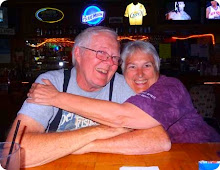Mechanicsville, VA High 73 Low 54
We visited the site of the Polegreen Church. The church was burned and those who are trying to preserve the history of the church put up this frame showing where the original building stood.
The following information was taken from the Polegreen Church web site. Fascinating story.
Patsy
In the late 1730's a powerful religious movement, which became known as the "Great Awakening" took hold in the middle colonies of America. In 1739 a Hanover County brick mason named Samuel Morris gathered his family and some neighbors into his home regularly on Sunday afternoons to read the Bible and religious tracts, including George Whitefield's sermons. This was the beginning of the dissenter movement in Virginia.
Tom and Jim
By 1743 the Governor's Council in Williamsburg licensed four dissenter "reading houses", three in Hanover County and one in Henrico. They were all named "Morris Reading Houses". The reading house built on Samuel Morris' land was named after George Polegreen, a land grant recipient of the previous century.
This framework shows where the original reading house was located.
At the request of the Hanover dissenters a newly ordained 23-year-old Presbyterian minister from Pennsylvania arrived in 1747 to be pastor of the four congregations which had been licensed by the Colonial government in 1743. Samuel Davies was the first non-Anglican minister licensed to preach in Virginia. Among his achievements was his pioneering effort in the education of black slaves. The classic negro slave spiritual, "Lord, I want to be a Christian in my heart" originated at Polegreen.
Patrick Henry worshipped with his mother, a Hanover dissenter, at Polegreen during the twelve years Davies was in Virginia.

In war-ravaged Hanover County the congregation which had worshipped at Polegreen could not afford to rebuild the destroyed church.





Funny, considering that some groups came to America to be allowed to have freedom of religion.
ReplyDeleteInteresting post. I really like the way they put just a frame of the old church...windows and all. Gives me a better idea of what it might have looked like.
ReplyDeleteI am some what of a Civil War buff, so I am enjoying your history posts. Looks like you are having a great time!
ReplyDeleteGreat history lesson.
ReplyDeleteI feel sorry for non-believers in early Virginia as their lives were made miserable. It's ironic that many Americans want those old days where everyone must believe the same way. Thank heaven for separation of church and state!
ReplyDeleteSandie, I'm sure enjoying your tour of the east. Your writings are appreciated.
ReplyDeleteMany churches, court houses and homes were destroyed during that time period. Such a pity to have so much history burned.
ReplyDeleteGreat tour! Thanks! Jim is really lookin good!
ReplyDeleteVirginia was a total wasteland after the Civil War from the armies fighting back and forth and foraging for food, firewwood and shelter. The church is just one example of the terrible destruction.
ReplyDeleteHope that history is never repeated.
another interesting post of the history of the area,
ReplyDeletegreat pictures.
A great history lesson. Haven't been to this area of the US yet.
ReplyDelete